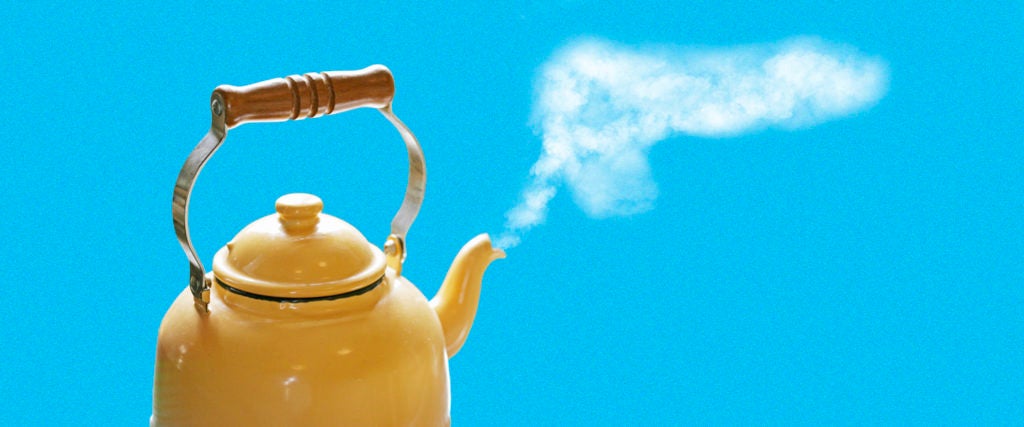A few years ago, 70-year-old anesthetist Sal Ciresi, who works at Novant Health in North Carolina, started experiencing symptoms of an enlarged prostate. He found himself crossing his legs in the operating room, calling for colleagues to fill in so he could rush to the toilet and even restricting his liquid intake so he wouldn’t have to go as often.
It wasn’t long before things took a turn for the worse. Ciresi began spontaneously leaking and carried backup underwear wherever he went. He doubted his ability to continue lecturing at anesthesia conferences, because it was becoming increasingly challenging to speak publicly when his bladder could give way at any moment. He even hesitated to travel. “We wanted to go to Disney World with the grandkids,” he tells me. But maintaining a mental inventory of every nearby bathroom would pose problems.
Such is life for many aging men. Around 50 percent of guys between the ages of 51 and 60 have an enlarged prostate, formally known as benign prostatic hyperplasia (BPD). For men older than 80, that percentage goes up to 90. “If guys live long enough, they’re going to get an enlarged prostate,” says Michael Herman, director of urology at Mount Sinai South Nassau hospital in New York.
And when you have an enlarged prostate, it pushes against the urethra, which is what causes all those aforementioned urinary troubles.
Up until recently, there haven’t been many good treatment options for an enlarged prostate. There are pharmaceuticals, which relax the muscle tissue around the prostate or shrink it altogether. But they need to be taken daily and can cause side effects like erectile dysfunction and retrograde ejaculation, a semen-less orgasm. There’s also a soon-to-be-outdated surgery called transurethral resection of the prostate (TURP). It involves carving or lasering away intrusive parts of the prostate but may breed many of the same side effects and requires months of recovery. (The surgery has earned the nickname “roto-rooter” due to its extreme approach at clearing up your pipes.)
Understandably, neither option sounded good to Ciresi. His prostate was already too large to be treated with medications, and he dreaded the thought of undergoing a TURP. But his wife was encouraging him to take his life back, and he knew something had to be done. “Men tend to be great deniers,” he says.
It was around this time that Ciresi heard a commercial on his car radio for Rezūm, a minimally-invasive procedure that uses sweltering water vapor delivered by a device pressed into your urethra to meticulously remove surplus prostate tissue. Compared to TURP procedures, water vapor is much less destructive. It kills targeted prostate cells and allows your body to expel them on its own. As a result, there are fewer side effects, and the procedure can be done without needing to be put under in the hospital. In fact, a urologist can perform it right in their office.
It’s worth noting, too, that there are other, similar treatments out there, like Aquablation, which uses high-pressure saline to remove excess prostate tissue. “It’s a new era for prostate treatment,” Herman says, adding that most of these modern treatments require less down time and are just generally more approachable. “It’s nice to have options.”
The one downside is that they can certainly be uncomfortable, and while easier on the body than a TURP, they still require some recovery time (more on that in a moment). It’s most important that you speak with your urologist about options, because the best procedure for you depends on your anatomy. For all these reasons, Herman says some people, especially anyone who’s understandably opposed to having something put into their urethra, may find that medication works just fine. So again, weigh your options.
But back to Ciresi: Galvanized by the thought of being able to meet his grandkids at Disney World in a few weeks, he scheduled an appointment for the Rezūm treatment. He was dosed with laughing gas, and the procedure was done in just a few minutes. “There was a fair amount of pressure down there,” he explains, but nothing he couldn’t handle. (There are others out there, however, who claim that the pain was unbearable. “I had to be put out to have it done,” an online forum lurker writes. “They tried to do it while I was awake, but I couldn’t stand the pain.”)
Ciresi had to wear a catheter for the next week and says there was some blood in his urine, but that’s to be expected. As an added bonus, he was able to work the very next day. Once the catheter was removed — which again, can be painful — he went home for his first post-op pee. “That was a big deal,” he says. It was a good pee, indeed.
The impromptu trips to the bathroom dissipated over the next few weeks, and the force behind Ciresi’s pee stream grew stronger. He stopped calling for colleagues to take over mid-operation, and he wasn’t worried about travel or lectures anymore. “I could throw out the extra underwear,” he says. “It was a pretty dramatic change for me.”
And all it took was a few minutes of steam up the pee hole.

